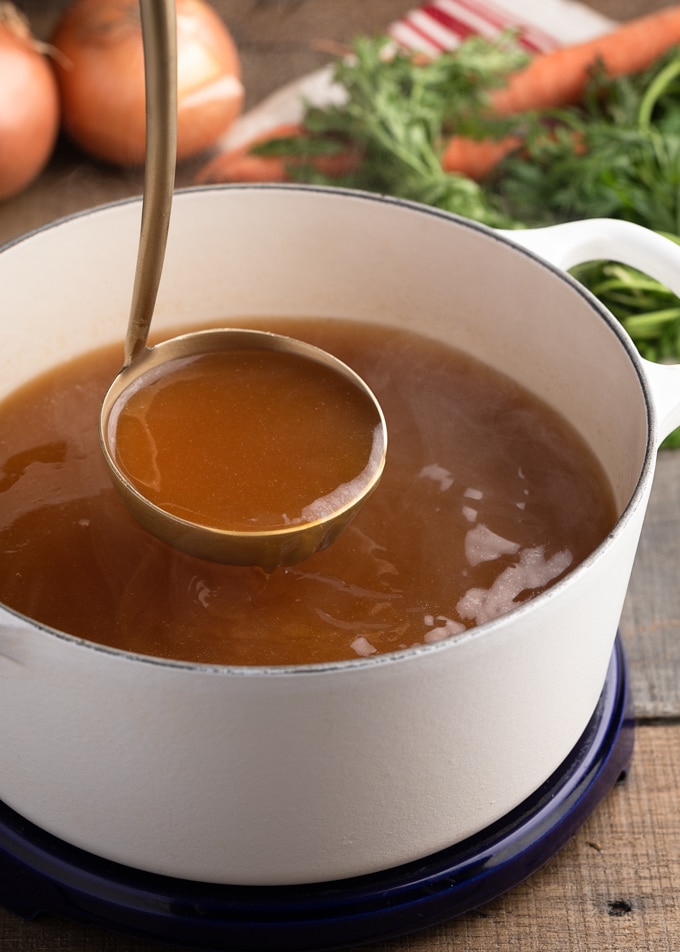Turkey Stock: Benefits, Recipe, and Storage Tips
Turkey stock is a flavorful liquid made by simmering turkey bones, meat, and vegetables. You’ll use turkey carcass, water, onions, carrots, celery, and herbs. Simmer these ingredients for several hours to extract their rich flavors and nutrients. Unlike broth, stock has a thicker consistency and deeper taste due to the gelatin released from the bones. Fresh herbs like thyme and parsley, along with bay leaves and peppercorns, enhance the stock’s complexity.
Health Benefits of Turkey Stock
Turkey stock contains essential nutrients like collagen, vitamins, and minerals. Collagen supports joint health and improves skin elasticity. Magnesium and phosphorus strengthen bones, while vitamins B6 and B12 boost your immune system and energy levels. The stock also aids digestion by adding gelatin, which can soothe the gut lining. Drinking turkey stock can help hydrate the body, support muscle health, and provide a comforting source of nourishment.
How to Make Turkey Stock at Home
Necessary Tools and Ingredients
To make turkey stock at home, gather these essential tools and ingredients:
Tools:
- Large stockpot
- Strainer or colander
- Ladle
- Slotted spoon
- Storage containers
Ingredients:
- Turkey carcass and bones (leftover from roast turkey)
- 1-2 onions, roughly chopped
- 2-3 carrots, chopped
- 2-3 celery stalks, chopped
- 2-3 garlic cloves
- 2-3 bay leaves
- Fresh herbs (parsley, thyme)
- 8-10 cups of water
- Salt and pepper to taste
- Prepare the Ingredients: Break down the turkey carcass into manageable pieces. Chop onions, carrots, and celery. Peel the garlic cloves.
- Combine in Stockpot: Place turkey bones, onions, carrots, celery, garlic, and herbs in a large stockpot. Add water until ingredients are covered.
- Simmer the Stock: Bring the pot to a boil over medium-high heat. Reduce to a simmer and cook for 4-6 hours. Skim off any foam with a slotted spoon.
- Strain the Stock: After simmering, remove large solids with a slotted spoon. Pour the stock through a fine-mesh strainer or colander into another container, discarding the solids.
- Season the Stock: Add salt and pepper to taste after straining.
- Cool and Store: Let the stock cool to room temperature. Divide into storage containers and refrigerate or freeze for later use.
Differences Between Turkey Stock and Turkey Broth
The Cooking Process
Turkey stock and turkey broth differ primarily in their cooking processes. Turkey stock involves simmering turkey bones (including cartilage and connective tissue) over a longer period, typically 4 to 6 hours. This cooking time extracts collagen, producing a gelatinous texture when cooled.
Turkey broth, on the other hand, cooks for a shorter time, around 1 to 2 hours, focusing on the meat rather than bones. This results in a lighter, less gelatinous liquid. While both methods can include vegetables (like onions, carrots, and celery) and seasonings for added flavor, the broth usually has a more pronounced, delicate flavor due to the shorter cooking time and emphasis on meat.
Nutritional Differences
Turkey stock generally has higher nutrient content compared to turkey broth. Since turkey stock simmers longer and incorporates bones, it provides a significant amount of collagen. This collagen supports joint health, skin elasticity, and gut health. Stock also offers minerals like calcium, magnesium, and phosphorus leached from the bones during prolonged cooking.
Turkey broth, because of its shorter cooking time and focus on meat, contains less collagen and fewer minerals. However, it’s still a good source of protein and can be lower in fat depending on the specific parts of the poultry used. While both can be rich in vitamins and amino acids, the broth is often lighter in texture and flavor, making it suitable for those preferring a less robust liquid.
Tips for Enhancing Turkey Stock
Adding Herbs and Spices
Including herbs and spices can significantly elevate your turkey stock’s flavor profile. Add aromatics like thyme, rosemary, and sage to infuse earthy and savory notes. Include bay leaves for a subtle bitterness that balances other flavors. Utilize peppercorns to introduce a slight heat and depth. As an example, three or four sprigs of thyme, two bay leaves, and a teaspoon of whole peppercorns work well in a large stockpot. Other complementary spices include cloves for warmth and star anise for a mild licorice taste. Ensure all herbs and spices are fresh for optimal extraction of essential oils and flavors.
Cooking Techniques to Maximize Flavor
Different cooking techniques can greatly impact the richness and taste of turkey stock. Roast bones before simmering to develop a hearty, deep flavor. Place bones in a 400°F oven for 40 minutes, turning halfway through. Use a slow simmer, never a boil, to prevent fat emulsification which clouds the stock. Skim foam and impurities from the top during cooking to ensure clarity and purity of flavor. Extend simmering time to at least 6-8 hours to extract maximum collagen and nutrients. For instance, for clearer stock, strain it through a cheesecloth or fine mesh sieve after simmering. Employ a pressure cooker to reduce cooking time while still achieving a rich, flavorful stock. Set it at high pressure for 2 hours, adjusting based on the cooker instructions.
Storing and Preserving Turkey Stock
Refrigeration and Freezing Methods
Refrigerate turkey stock to keep it fresh for up to 4 days. Pour the stock into airtight containers before refrigerating to prevent contamination. Fill the containers leaving some headroom as the liquid might expand.
Freeze turkey stock for longer storage. Use freezer-safe containers or heavy-duty freezer bags. Portion the stock into smaller quantities, about 1 cup per portion, to make it easier to use later. Label each container with the date of freezing and the content. To save space, you can lay freezer bags flat while freezing before stacking them.
Shelf Life and Safety Tips
Always follow shelf life guidelines for optimal safety. Refrigerated turkey stock lasts for four days, while frozen stock stays good for up to six months. If the stock smells sour or has an off appearance, discard it immediately.
When reheating, boil the stock to ensure it’s safe for consumption. Over time, small amounts of air enter containers, which may degrade the quality. Use proper storage methods to maximize shelf life and maintain flavor.
Conclusion
Creating your own turkey stock not only enhances the flavor of your dishes but also provides numerous health benefits. By following proper storage and safety guidelines, you can enjoy your homemade stock for weeks or even months. Remember to label your portions and always check for signs of spoilage before use. With these tips, your turkey stock will remain a versatile and nutritious addition to your culinary repertoire.





